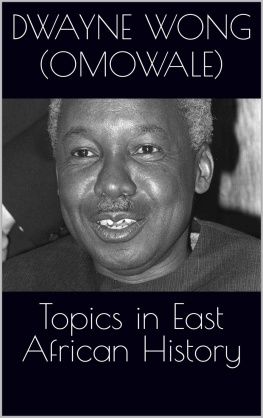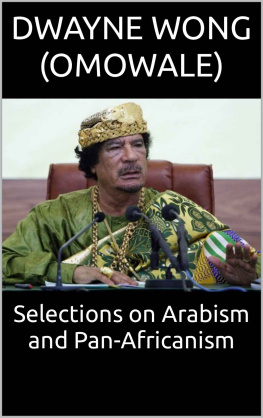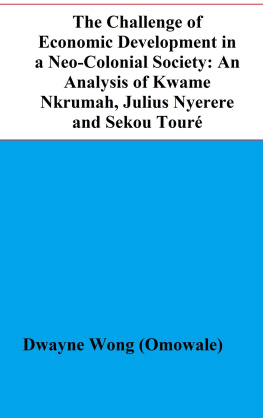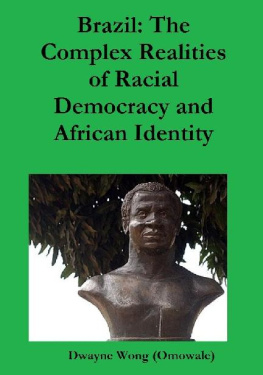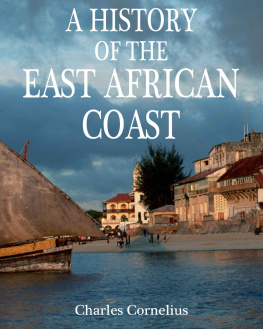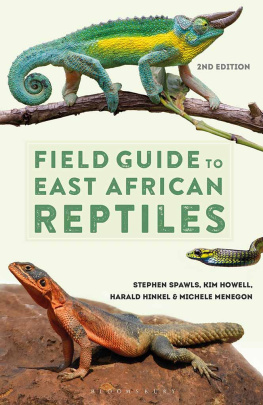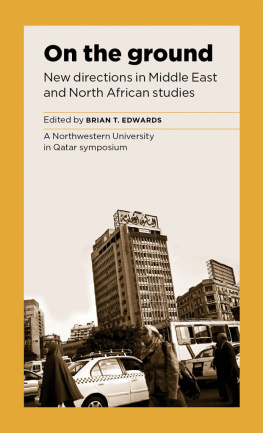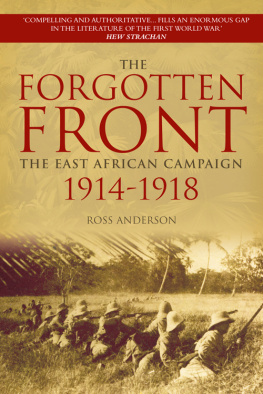Dwayne Wong (Omowale) - Topics in East African History
Here you can read online Dwayne Wong (Omowale) - Topics in East African History full text of the book (entire story) in english for free. Download pdf and epub, get meaning, cover and reviews about this ebook. year: 2022, genre: History. Description of the work, (preface) as well as reviews are available. Best literature library LitArk.com created for fans of good reading and offers a wide selection of genres:
Romance novel
Science fiction
Adventure
Detective
Science
History
Home and family
Prose
Art
Politics
Computer
Non-fiction
Religion
Business
Children
Humor
Choose a favorite category and find really read worthwhile books. Enjoy immersion in the world of imagination, feel the emotions of the characters or learn something new for yourself, make an fascinating discovery.
- Book:Topics in East African History
- Author:
- Genre:
- Year:2022
- Rating:4 / 5
- Favourites:Add to favourites
- Your mark:
- 80
- 1
- 2
- 3
- 4
- 5
Topics in East African History: summary, description and annotation
We offer to read an annotation, description, summary or preface (depends on what the author of the book "Topics in East African History" wrote himself). If you haven't found the necessary information about the book — write in the comments, we will try to find it.
Topics in East African History — read online for free the complete book (whole text) full work
Below is the text of the book, divided by pages. System saving the place of the last page read, allows you to conveniently read the book "Topics in East African History" online for free, without having to search again every time where you left off. Put a bookmark, and you can go to the page where you finished reading at any time.
Font size:
Interval:
Bookmark:
Topics in East African History
by
DwayneWong (Omowale)
Copyright 2022Dwayne Wong (Omowale)
All rightsreserved.
The ColonialNature of Meneliks Ethiopia
Ethiopia (also known as Abyssinia) standsout as the only African nation that was able to successfully defeat an invadingEuropean power to escape being colonized. The man responsible for leadingEthiopia into this victory was Emperor Menelik II. Yet in defeating the colonists,Menelik had not truly saved his nation from the adverse impact of Europeancolonialism in Africa. As will be argued here, the nation that Menelikconstructed was very much like the African nations that had been colonized byEuropeans. The number of civil wars and other conflicts that many Africannations have endured were in large part related to the legacy left over bycolonialism. The colonialists employed divide and rule tactics to pit ethnicgroups against each other. Although ethnic groups in Africa had often foughtwith each other, there was never the outright tribal hatred that wasestablished by Europeans through colonial rule. In speaking about the emergenceof tribalism in Nigeria that would lead to a civil war there, Walter Rodneyexplained:
Of course there were wars,but they had a rational basis in trade rivalry, religious contentions, and theclashes of political expansion. What came to be called tribalism at thebeginning of the new epoch of political independence in Nigeria was itself aproduct of the way that people were brought together under colonialism so as tobe exploited.
An aspect of these tribal wars was theborders that the Europeans drew up, which did not match the ethnic makeup ofAfrica. This was one of the issues that led to the civil war in Nigeria, inwhich many of the Ibo people attempted to separate from Nigeria and establish anation of their own. Ethiopia did not undergo the same colonial process and asa result of the borders in Ethiopia were not directly established by Europeans,although Europeans indirectly established Ethiopias borders. As Menelik wasexpanding his kingdom, the Europeans were conquering the territories aroundMenelik. Therefore, the Europeans effectively drew up the borders thatsurrounded Ethiopia. This was one aspect of the tribal problem that Ethiopiawould face, but another aspect of this was the manner in which Ethiopia wasconsolidated. The factors that contributed to the rise of ethnic conflicts inEthiopia shall be elaborated on later, but the point that is to be made here isthat Ethiopia had not been colonized, but Ethiopia would face many of the sameissues that other colonized African nations have had to face.
It is worth noting from the onset thatprior to Meneliks rule Ethiopias central government had been weakened and wasnow beginning to regain its strength following that period of weakness. This was a period known as the Zemene Mesafint (Eraof the Princes), which lasted from 1796 until 1855. This crisis arose duringthe reign of Iyoas , who was the son of Iyasu II. Apolitical figure known as Ras Mikael Sehul managed tobuild up large armies and established political power of his own. His powersurpassed that of the Ethiopian monarch to such extent that Mikael Sehul was able to have two kings ( Iyoas and Yohannes II) murdered.
Mikael Sehuls actions weakened the central government to the point that a unified kingdom nolonger existed. Regional rulers waged wars with each other for control. By1800, there were as many as six rivaling emperors. A central monarchy wasfinally reestablished by Tewodros II, who was crowned in 1854. Tewodros IIbegan the process of reunifying the fragmented kingdom, but the violence andinstability in the region continued.
Although Tewodros began the process ofunifying Ethiopia, he was never able to complete the process. Tewodros died in1868. Tewodros sought the assistance of the British in a plan to conquer theTurks in Jerusalem. Disagreements arose and Tewodros decided to take theBritons as hostages. An expedition was sent to Ethiopia to rescue the hostages.In the ensuing battle the Ethiopian forces were defeated and Tewodros committedsuicide to avoid being captured.
Following Tewodros death there was ascramble for control of the kingdom between the many contenders. In 1872, Kasa Mercha was crowned, takingthe royal name Yohannes IV (known as John by the Europeans). Yohannes ruledfrom 1871 until 1889. Yohannes continued Tewodros process of uniting theEthiopian kingdom. As Yohannes ruled inthe north, in the south Menelik was expanding his own influence. Although Menelik was subordinate toYohannes and paid tribute to him, Meneliks goal was to become the ruler ofEthiopia. To this end Menelik often maintained relations with Yohannesenemies. Yohannes was killed in 1889 during the Battle of Metema which was fought against the Mahdists in the Sudan. With Yohannes out of theway, Menelik became the new emperor of Ethiopia.
Meneliks reign is significant in that hewas the only African monarch to successfully repel the European colonists.Menelik had actually been an ally of Italy prior to the war between the twonations. The war between Italy and Ethiopia was sparked by the Treaty of Wuchale , which was signed between Menelik and CountAntonelli. Antonelli had been in Meneliks court for years, working as both adiplomat and an arms dealer. Antonellimanaged to win Meneliks trust. He drew up the treaty, which Menelik signed. Controversy arose over Article XVII ofthe treaty. There were two texts of the treaty, one in Amharic and one inItalian. Article XVII differed between the two versions. The Amharic versionstated that Menelik had the option to seek the services of Italy beforecommunicating with other nations, but the Italian text made it mandatory. TheItalian text essentially made Ethiopia a protectorate. Menelik sent his cousinRas Makonnen, who was the governor of Harar, to Italy for negotiations. Out ofthese negotiations it was agreed that Italy would recognize Menelik as theemperor and that Menelik would recognize Italys control over Eritrea. Thenegotiations also produced a 4,000,000 lire loan to Ethiopia from Italy.
Tensions arose again when the ItalianForeign Minister Crispi declared: His Majesty the King of Ethiopia consents toavail himself of the Government of His Majesty the King of Italy for the conductof all matters which he may have with other Powers of Governments. Thisstatement was yet another assertion of Italys claim of a protectorate overEthiopia. This claim was also recognized by other European nations. Europeanmaps began referring to the country as Italian Abyssinia. Menelikscoronation was set for November 3, 1889. Menelik sent news of his coronation tothe European powers, but they responded that they could not deal with himdirectly since Ethiopia was an Italian protectorate and that the communicationhad to be made through Italy.
Menelik refused to accept the terms of thetreaty. He wrote to King Umberto I of Italy to explain the issue over ArticleXVII:
When I made that treaty offriendship with Italy, in order that our secrets be guarded and that ourunderstanding should not be spoiled, I said that because of our friendship ouraffairs in Europe might be carried on with the aid of the Sovereign of Italy,but I have not made any treaty which obliges me to do so, and today, I am notthe man to accept it. That one independent power does not seek the aid ofanother to carry on its affairs your Majesty understands very well.
The two reached a deadlock in which Italyrefused to change the terms of the treaty. Antonelli told Menelik that Italycannot notify the other Powers that she was mistaken in Article XVII, becauseshe must maintain her dignity. To this, Empress Taitu responded, we also ought to respect our dignity. You wish Ethiopia to berepresented before the other Powers as your protectorate, but this shall neverbe. After the controversy that emerged from this treaty Menelik seemed to havebeen very cautious regarding the wording of treaties. Edward Gleichen foundMenelik to be clear-headed and acute, but simple-minded withal, and dreadfullyafraid of being taken in by those enigmatic phrases and thoseconditions-within-conditions so dear to the diplomatic mind. Menelik had the treaty he made withGleichens group also translated in French, in case there was a disagreementbetween the English and Amharic texts.
Next pageFont size:
Interval:
Bookmark:
Similar books «Topics in East African History»
Look at similar books to Topics in East African History. We have selected literature similar in name and meaning in the hope of providing readers with more options to find new, interesting, not yet read works.
Discussion, reviews of the book Topics in East African History and just readers' own opinions. Leave your comments, write what you think about the work, its meaning or the main characters. Specify what exactly you liked and what you didn't like, and why you think so.

